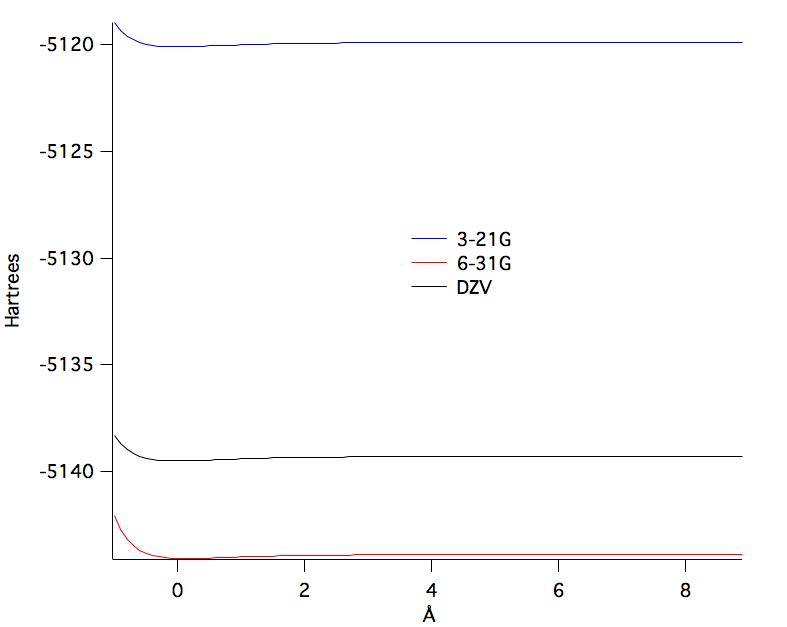Di-bromine
Bromine is the 35th element on the periodic table.
It has 7 valance electrons making it an electronegative
element. It can form a homo-nuclear non-polar diatomic
molecule.
Several levels of theory were used to examine di-bromine.
Comparing the calculated results to experimental data it was
found that 6-31G basis set was the most accurate. This is
notable because the DZV basis set is larger than the 6-31G basis
set; normally a larger basis set is associated with greater
accuracy.
Back to home page
|
|
Jmol0 will appear here.
|
|
|
CLICK IMAGE TO
ACTIVATE 3D
Molecular Geometry |
|
Bond
Length
The bond length from each theory of calculation used
and from experimental data is shown in table 1
below. Notice that the 6-31G basis set agrees
most completely with the experimental data.
Table 1
Theory Level
|
Bond Length (Å)
|
Experimental1
|
2.28
|
DZV
|
2.43 |
6-31G
|
2.41
|
3-21G
|
2.44
|
|
|
|
Jmol1
will appear here.
|
|
|
CLICK IMAGE
TO ACTIVATE 3D
HOMO |
|
HOMO
The highest occupied molecular orbital
was found by taking the number of electrons and
dividing it by 2. The HOMO for di-bromine
shown here is the 35th orbital.
|
|
|
|
Jmol2 will
appear here.
|
|
|
CLICK IMAGE TO
ACTIVATE 3D
Insert a caption for LUMO here. |
|
LUMO
The LUMO is shown to the left. The LUMO is the
lowest unoccupied molecular orbital. Because the
HOMO for di-bromine is the 35th orbital, the LUMO is
the 36th orbital.
|
|
|
Jmol3
will appear here.
|
|
|
CLICK IMAGE TO
ACTIVATE 3D
Di-bromine's vibrational mode |
|
Vibrational Modes
Di-bromine has 1 vibrational mode. The calculated
vibrational energy using the 6-31G was 303.73
cm-1. As discuses in the molecular geometry
section, the 3-61G theory better predicted the molecular
geometry than the DZV theory. Interestingly, the
DZV predicted a vibrational energy that was closer to
the experimental values even with its less accurate
molecular geometry. The DZV theory predicted the
vibrational energy to be 310.03cm-1 while the 6-31G
predicted 303.73cm-1. Both theories underestimated
the vibrational energy by approximately 25%. The
experimental vibrational energy 325cm-1. 1
Potential Energy vs. Bond Length

The graph above shows the potential energy of
di-bromine. The potential energy well reaches
a minimum at the predicted bond length 2.41 A.
Potential Energy For Three Levels of Theory

Although the potential energy wells are not as
visible on this graph, it illustrates the difference
in energy predicted by the three theories. The
6-31G predicted the lowest, most stable energy for
di-bromine. This along with it's superior
molecular geometry calculations led to the
conclusion that the 6-31G theory is the best on out
of the three used for di-bromine.
Bonding Orbital Energy Level

The center column show the Br2
molecular orbitals. The bond order is 1. This agrees with
the classic Lewis structure drawing depicting Br2 with a single
bond.
Back to home page
References
1.National Institute of Standards and Technology. Listings of
experimental data for Br2.
http://cccbdb.nist.gov/exp2.asp?casno=7726956 (accessed Mar 11,
2014).
|
|
Based on template by A.
Herráez as modified by J. Gutow
Using directory /Users/student/Documents/RobErica/Br2/Br2_6-31G_html
adding JmolPopIn.js
...jmolApplet0
...adding 6-31G_Bond_Length.png
copying and unzipping jsmol.zip directory into /Users/student/Documents/RobErica/Br2/Br2_6-31G_html
...copying
file:/Users/student/Documents/RobErica/Br2/6-31G.log
to
...compressing large data file to
/Users/student/Documents/RobErica/Br2/Br2_6-31G_html/6-31G.log.gz
/Users/student/Documents/RobErica/Br2/Br2_6-31G_html/6-31G.log.gz
...adding 6-31G_Bond_Length.spt
...jmolApplet1
...adding HOMO.png
copying and unzipping jsmol.zip directory into /Users/student/Documents/RobErica/Br2/Br2_6-31G_html
...adding HOMO.spt
...jmolApplet2
...adding LUMO.png
copying and unzipping jsmol.zip directory into /Users/student/Documents/RobErica/Br2/Br2_6-31G_html
...adding LUMO.spt
...jmolApplet3
...adding Vibration.png
copying and unzipping jsmol.zip directory into /Users/student/Documents/RobErica/Br2/Br2_6-31G_html
...copying
file:/Users/student/Documents/RobErica/Br2/Br2_6-31G_vib.log
to
...compressing large data file to
/Users/student/Documents/RobErica/Br2/Br2_6-31G_html/Br2_6-31G_vib.log.gz
/Users/student/Documents/RobErica/Br2/Br2_6-31G_html/Br2_6-31G_vib.log.gz
...adding Vibration.spt


